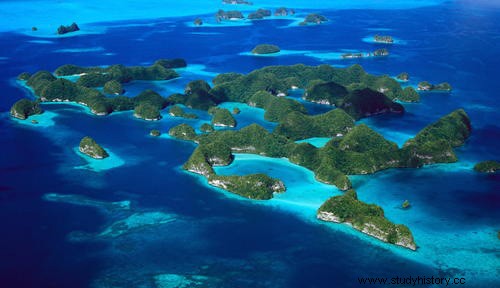The Treaty of Paris of 1898, signed on December 10, put an end to the Spanish-American War –Disaster of '98 – and gave the finishing touch to the Spanish overseas empire. Through this treaty, Spain abandoned its demands on Cuba and declared its independence, and the Philippines, Guam and Puerto Rico were officially ceded to the United States for 20 million dollars. A little later, we would receive another $100,000 for the Sibutú islands. , Cagayan and Jolo , forgotten at the signing of the treaty. Furthermore, after seizing Guam in a tragicomic way and due to the rush to get to Manila (Philippines), the American captain Henry Glass you “forgot » take the rest of the islands that made up the Marianas and the Carolinas, and we were able to get 17 million marks by selling them to the German Empire in 1899. They were the last possessions of the Spanish overseas empire... or maybe not.
The archipelagos of Os Guedes , As Coroas , O-Cea and The Fishermen , located in the Pacific Ocean, were discovered and occupied by the Portuguese. After the Restoration In 1640, Portugal regained its independence from the Hispanic monarchy of the Habsburgs and ceded the archipelagos to our country in exchange for a part of the Moluccan Islands. This set and the Islands of Ponape and Ascension they were not included in the treaty of December 10, 1898, so they continued to be a territorial possession of Spain.

During the Franco regime, the diplomat of the Higher Council for Scientific Research (CSIC) Emilio Pastor y Santos discovered that International Law protected Spain and could legally claim sovereignty over the so-called Spanish Micronesia . Despite the high cost that would have meant exercising its sovereignty and the low strategic and economic value of those simple atolls, the issue was dealt with on January 12, 1949 in the Council of Ministers, but any claim was dismissed as Spain did not belong to the UN. -it would not be admitted until December 14, 1955- and due to the fear of confrontations with powers such as the United States or Japan.
Although it has not officially renounced its possession, Spain has never exercised its sovereignty over these territories nor has it claimed them. Currently, Os Guedes Atoll, also known as Mapia Island, is under the jurisdiction of Indonesia; Os Pescadores (Kapingamarangi) and O-Cea under the political sovereignty of the Federated States of Micronesia, and As Coroas (Rongerik) under the control of the Republic of the Marshall Islands.
Collaboration with Javier Ramos from Places with History.
